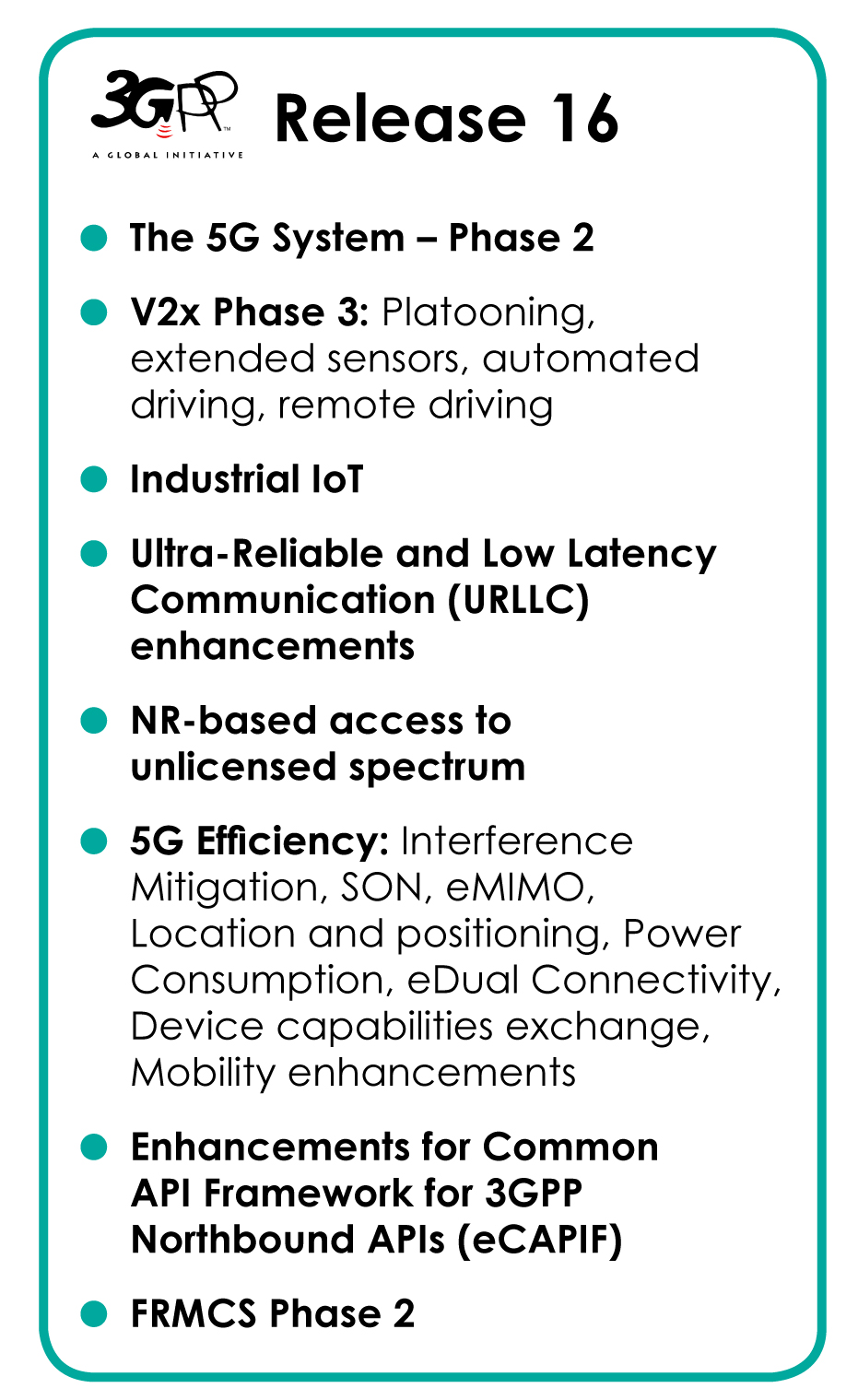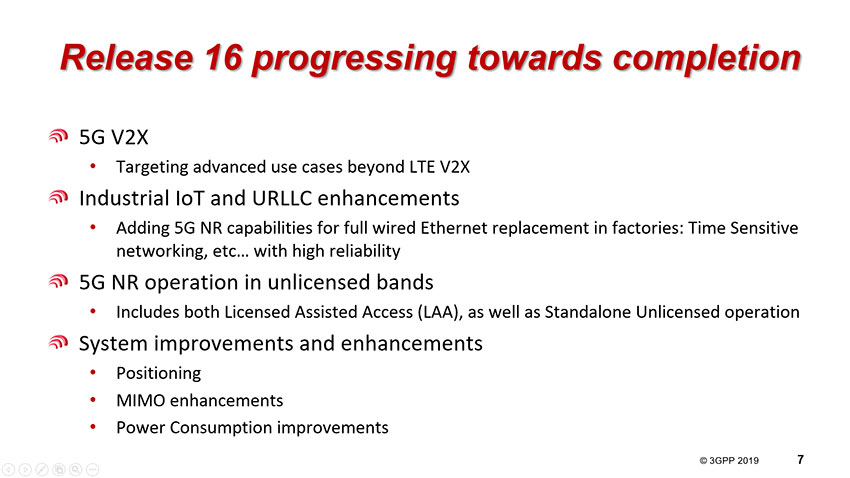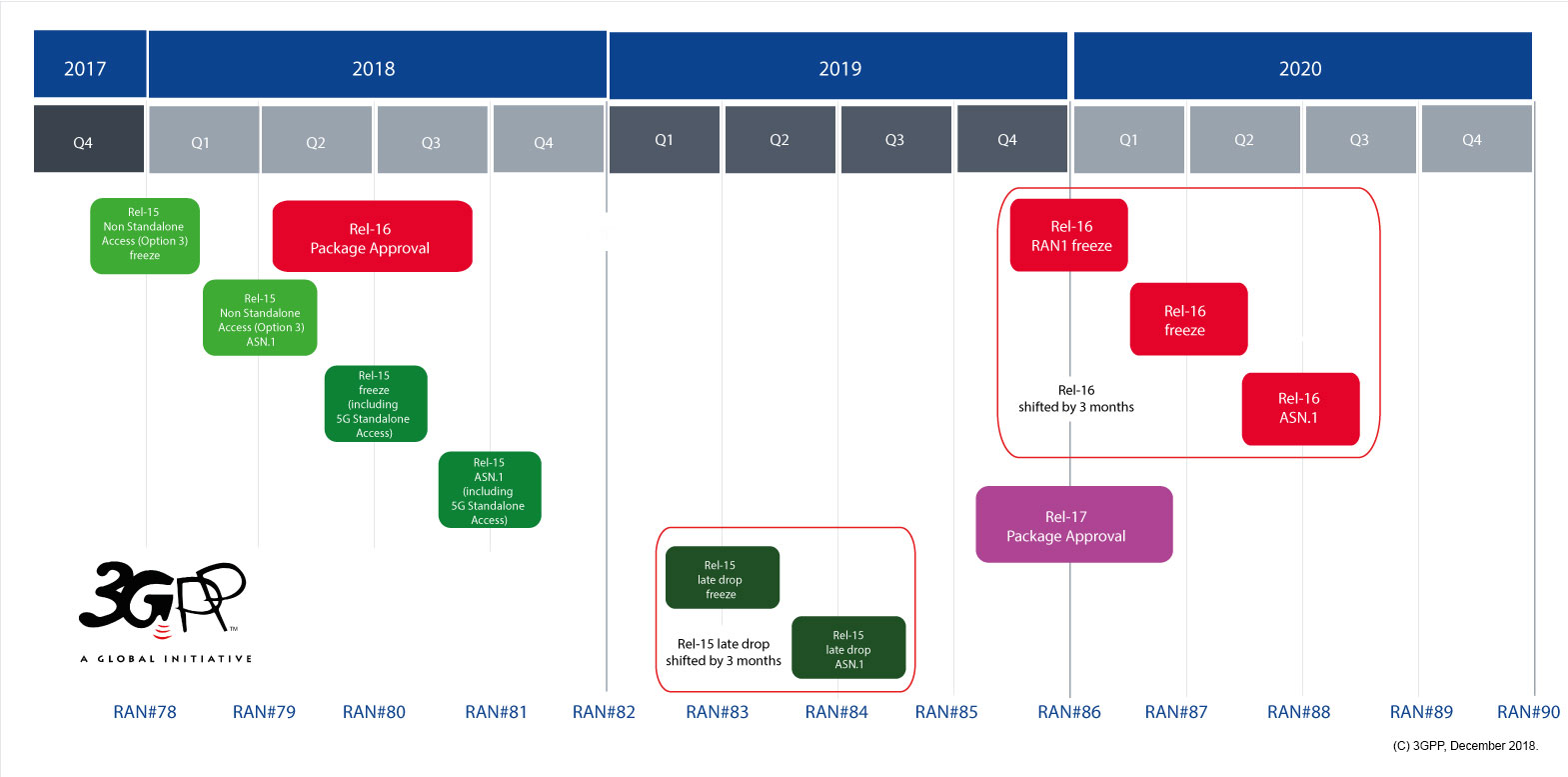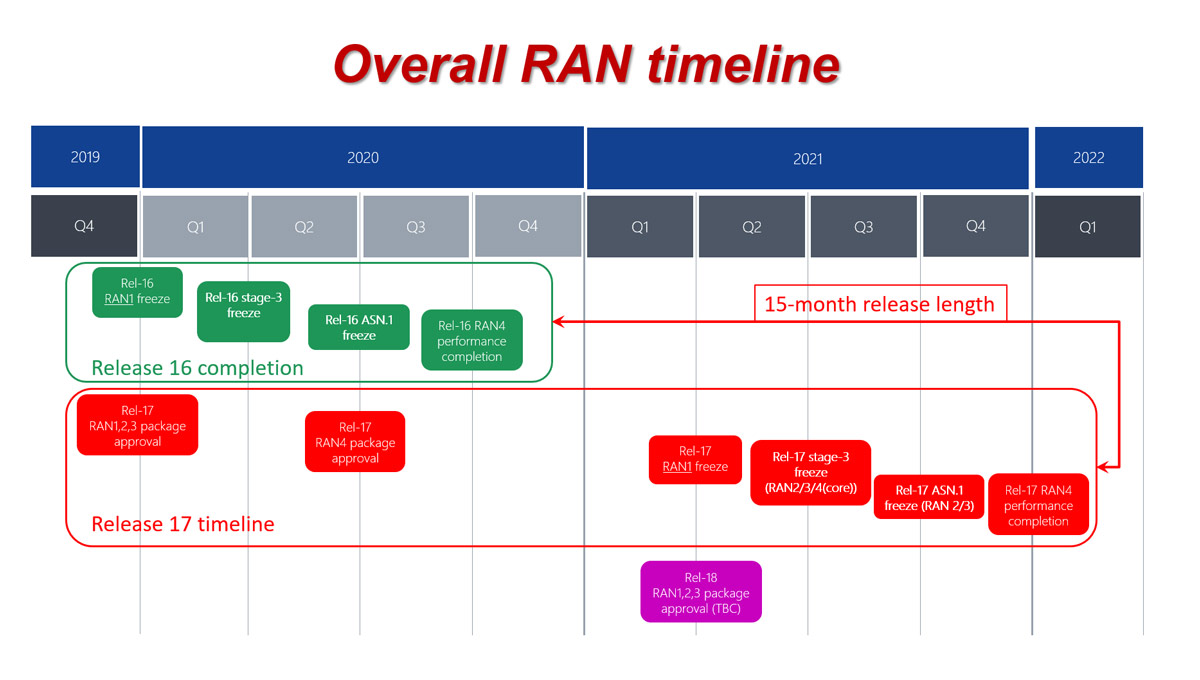3GPP Release 16 Update: 5G Phase 2 (including URLLC) to be completed in June 2020; Mission Critical apps extended
NOTE: This article is intended as a reference, which is especially important to debunk claims made about current pre-standard 5G deployments which are almost all based on 3GPP Release 15 “5G New Radio (NR)” for the data plane with LTE signaling and LTE mobile packet core (EPC) for Non Stand Alone (NSA) operation. 5G pundits continue to site 3GPP as the standards organization responsible for 5G which is doubly wrong because it’s not a standards body and submits its 5G/IMT 2020 proposals to ITU-R WP 5D via the latter organizations member entities. As we’ve stated many times before, ITU-R is responsible for the radio standards for IMT 2020, while ITU-T is working on the non-radio aspects of IMT 2020.
………………………………………………………………………………………………………………………………………………………………………………………………………………..
Summary:
3GPP Release 16 is a major release for the project, because it will bring the specification organization’s IMT-2020 RIT/SRIT submission (to ITU-R WP 5D) for an initial full 3GPP 5G system to its completion. Release 16 will be put in a “frozen” state in March 2020 with a targeted completion date of June 2020.
3GPP work has started on approximately 25 Release 16 studies, which cover a variety of topics: Multimedia Priority Service, Vehicle-to-everything (V2X) application layer services, 5G satellite access, Local Area Network support in 5G, wireless and wireline convergence for 5G, terminal positioning and location, communications in vertical domains and network automation and novel radio techniques. Further items being studied include security, codecs and streaming services, Local Area Network interworking, network slicing and the IoT.
Here are the new features planned for 3GPP Release 16:
Details of the features and work items under each 3GPP Release are kept in the corresponding, on-line, list of features and study items.
- Enhancement of Ultra-Reliable (UR) Low Latency Communications (URLLC)
- 5GS Enhanced support of Vertical and LAN Services
- Cellular IoT support and evolution
- Advanced V2X support
- 5G Location and Positioning Services
- UE radio capability signalling optimization
- Satellite Access in 5G
- Enablers for Network Automation Architecture for 5G
- Wireless and Wireline Convergence Enhancement
- Mission Critical, Public Warning, Railways and Maritime
- Streaming and TV
- User Identities, Authentication, multi-device
- (Network) Slicing
- Other cross-TSG Release 16 Features
- NR-related Release 16 Features
- Release 16 Features impacting both LTE and NR
- LTE-related Release 16 Features

From 3GPP’s July 18, 2019 Webinar:

“For the (industry) verticals, there are three distinct pillars that we are focused on: Automotive, Industrial IoT and Operation in unlicensed bands. For 5G based V2X, which builds on the two iterations of the LTE-V2X, we are now adding advanced features – primarily in the area of low latency use cases.
The second focus is industrial IoT and URLLC enhancements. Factory automation, in particular, is a strong pillar for 5G going forward. We are trying to ensure that the radio side covers all of the functions that all the verticals need for factory automation. What this means in practice is that we are trying to make sure 5G NR can fully replace a wired ethernet – currently used – by adding time sensitive networking and high reliability capabilities.
The third pillar is operation in unlicensed bands. We have seen different schemes for generic 5G licensing strategies in Europe and in other parts of the World. We have seen in some countries that certain licensed bands have been allocated for vertical use cases, though that is not the case for a majority of countries. The use of unlicensed bands provides a great opportunity – where licensed spectrum is not an option. We are now focused on not only what we have with LTE, which is the licensed assisted access scheme, but also on standalone unlicensed operation – to be completed in Release 16.
Release 16 also delivers generic system improvements & enhancements, which target Mobile Broadband, but can also be used in vertical deployments – Particularly; positioning, MIMO enhancements and Power consumption improvements.”
………………………………………………………………………………………………………………………………………………………………………………………………….
Technical Reports (the result of the study phase) are also being developed on broadening the applicability of 3GPP technology to non-terrestrial radio access (initially satellites, but airborne base stations are also to be considered) and to maritime aspects (intra-ship, ship-to-shore and ship-to-ship). Work also progresses on new PMR functionality for LTE, enhancing the railway-oriented services originally developed using GSM radio technology that is now nearing end of life.
As part of Release 16, Mission Critical (MC) services will be extended to address a wider business sector than the initial rather narrow public security and civil defense services for which they had originally been developed. If the same or similar standards can be used for commercial applications (from taxi dispatching to railway traffic management, and other vertical sector scenarios currently being investigated), this would bring enhanced reliability to those MC services through wider deployment, and reduced deployment costs due to economies of scale – to the benefit of all users.

IMT-2020 – Final submission
- Calibration for self evaluation
- Prepare and finalize initial description template information that is to be submitted to ITU-R WP 5D#29.
Step 2: From early 2018 to Sep 2018, targeting “update & self eval” submission in Sep 2018
- Performance evaluation against eMBB, mMTC and URLLC requirements and test environments for NR and LTE features.
- Update description template and prepare compliance template according to self evaluation results.
- Provide description template, compliance template, and self evaluation results based on Rel-15 in Sep 2018.
Step 3: From Sep 2018 to June 2019, targeting “Final” submission in June 2019
- Performance evaluation update by taking into account Rel-16 updates in addition to Rel-15
- Update description template and compliance template to take into account Rel-16 updates in addition to Rel-15
- Provide description template, compliance template, and self evaluation results based on Rel-15 and Rel-16 in June 2019.
Some Background on Release 16
- See the full Release 16 Description – TR21.916 (Available at Release freeze)
- RAN Rel-16 progress and Rel-17 potential work areas (July 18, 2019)
- Early progress on Rel-16 bands for 5G (April 2, 2019)
- “Working towards full 5G in Rel-16”…See 3GPP webinar presentation (July 3, 2019)
- Preparing the ground for IMT-2020
- SA1 completes its study into 5G requirements
……………………………………………………………………………………………………………………………………………..
References:
https://www.3gpp.org/release-16
https://www.3gpp.org/news-events/2058-ran-rel-16-progress-and-rel-17-potential-work-areas
…………………………………………………………………………………………………………………………………………………………………………………………………….
Addendum (December 14, 2020):

https://www.3gpp.org/news-events/2098-5g-in-release-17-%E2%80%93-strong-radio-evolution
8 thoughts on “3GPP Release 16 Update: 5G Phase 2 (including URLLC) to be completed in June 2020; Mission Critical apps extended”
Comments are closed.




How will 3GPP Release 16 be input to ITU-R WP5D for inclusion in IMT 2020 RIT/SRIT?
WP 5D will hold a workshop on IMT-2020, focusing on the evaluation of the candidate terrestrial radio interfaces at its 33rd meeting taking place December 2019 in Geneva, at which interim evaluation reports are expected. This will help the IEGs understand the details of the proposed candidate technologies, and interact amongst themselves as well as other WP 5D participants. This workshop is a continuation of the previous one on IMT-2020 held in 2017, Munich, which addressed the process, requirements, and evaluation criteria for IMT-2020 as well as views from proponents on the developments of IMT-2020 radio interfaces and activities of the IEGs.
2 Objectives
The objectives of the workshop are as follows;
– to promote information sharing on IMT-2020;
– to facilitate dialogue within ITU-R WP 5D and amongst the proponents as well as the evaluation groups; and in particular;
• to review the final submissions of the proposed RITs/SRITs for IMT-2020;
• to review the evaluation results reported by the IEGs at this stage;
• to review the WP 5D template which will be used to summarise evaluation results for each IEG;
• to present the details of the proposed RITs/SRITs including self-evaluation results and detailed evaluation methods by the proponents;
• to introduce the evaluation activities and future plans of the IEGs,; and
• to review the outcome WRC-19 and its implication on IMT-2020 evaluations and further development.
3 Program
Please refer to the draft program of the Workshop in Attachment 1.
4 Schedule
The workshop will run from the 10th to 11th of December 2019 in conjunction with the 33rd meeting of WP 5D. Please refer to Attachment 2 for the anticipated high level time plan of the workshop and the WP 5D meeting.
In addition, in the course of meeting #33, the IEGs and proponents may wish to participate in the discussions in certain sessions of Working Party 5D meeting on Thursday and Friday.
5 Participants
WP 5D delegates, representatives from the proponents of the RITs/SRITs and representatives of the registered independent evaluation groups.
At this week’s quarterly 3GPP RAN Plenary meeting in the beautiful coastal city of Sitges, Spain, months-long discussions on 3GPP Release-17 (Rel-17) — the next phase of 5G standards — came to a conclusion, resulting in the approved package of 24 new projects that are expected to complete in the second half of 2021.
As expected, these new projects will continue to enhance the 5G NR technology foundation and further expand 5G’s reach in terms of enabling new services, deployments, and spectrum bands. Official work on Rel-17 will begin shortly after the new year. Here is a short overview of some of those projects.
https://www.qualcomm.com/news/onq/2019/12/13/3gpp-charts-next-chapter-5g-standards
3GPP RAN#86 held 9-12 December made substantial decisions regarding the further technology evolution of 5G NR radio. Nowhere is it more apparent, than in 3GPP RAN, that the 5G ecosystem is building out to be substantially more versatile than LTE.
A major achievement of the RAN plenary meeting was the approval of the content for Release-17 – both in terms of the list of features included and the detailed functionality within each feature. This decision addresses the work in RAN1, RAN2, and RAN3: physical layer, radio protocol and radio architecture enhancements. Further decisions will be made at RAN#88, in June next year, on the RAN4 work for Release-17.
For Release-17 the physical layer work in RAN1 will start at the beginning of next year, whilst radio protocol and architecture work in RAN2 and RAN3, respectively, will start in the 2nd quarter.
https://www.3gpp.org/news-events/2098-5g-in-release-17-%E2%80%93-strong-radio-evolution
Are 3GPP and ITU now irrelevant for 5G specs?
The 5G Future Forum will collaborate to develop interoperable 5G specifications across key geographic regions, including the Americas, Asia-Pacific and Europe. The Forum’s founding members are América Móvil, KT, Rogers, Telstra, Verizon and Vodafone.
The 5G Future Forum will focus on the creation of uniform interoperability specifications to improve speed to market for developers and multinational enterprises working on 5G-enabled solutions. In addition, Forum participants will develop public and private marketplaces to enhance developer and customer access to 5G, and will share global best practices in technology deployment.
https://www.verizon.com/about/news/global-5g-leaders-create-future-forum
Excellent Qualcomm interview on state of 3GPP release 16. Expect Rel 16 compatible products in 2022!
https://www.youtube.com/watch?v=xa0mmFQPZGE&feature=youtu.be
Manufacturer’s perspective, Louis Clement, VP Business Development & Wireless Strategy at Sanmina:
3GPP-Rel.16, now planned for late 2020, will enable Radio Access Network, RAN, features that will be strengthened and productized promoting increased industrial productivity, especially in areas of industrial automation and accompanying technologies like Augmented Reality that will substantially increase factory efficiency. The further enhancements in Ultra Reliable Low Latency Communications (URLLC), geo-localization & positioning, Time Sensitive Networking (TSN) and Network Slicing introduced in Rel.16 together mark a tipping point toward a more comprehensive and whole scale adoption of Industrial 5G in late 2020 and 2021.
The current US Rel.15 enhanced Mobile BroadBand, eMBB, first phase roll out, introduced in 2019, exploited the newly available FR2 mmWave spectrum 39GHz (AT&T) and 28GHz (Verizon) to open near Gigabit bandwidth Fixed Wireless Access (FWA) applications for large venues, especially sports arenas and stadiums. In Europe, the first Industrial 5G applications in their FR1 sub-6GHz spectrum focused on large campus sized deployments in mines, ports and expansive automotive manufacturing industrial parks. There the inherent security of cellular RAN to SIM connected devices and the improved geo-location features for Automatically Guided Vehicles (AGV’s) within Private or Dedicated Networks fuelled the first use cases. Multiple major German Automotive and Industrial companies even acquired their own spectrum licences.”
“New 5G device modules with Sub6, mmWave and GNSS (GPS) IC’s are being introduced later this year that will permit near centimeter level precise indoor positioning for tracking in-factory and warehouse material movements leading to better inventory accuracy, asset turnover and manpower efficiencies. Low Latency features will drive technologies like Augmented Reality for hands free order picking, complex assembly, machine maintenance and remote service assistance to double digit percent process improvements. URLLC will permit further robotic assembly improvements introducing increased factory flexibility and human-machine collaboration (similar to autonomous driving features) to respond to both steady and volatile demand patterns.
The Rel.16 RAN improvements in Network Slicing further promote in factory 5G Small Cell secure connectivity with accompanying Multi-Access or Mobile Edge Computing (MEC) not only running RAN Software functionality but on-premise applications like Visual Analytics digitizing factory movement of materials and people to be processed by Machine Learning (ML) and Artificial Intelligence (AI) algorithms for future supplementary productivity improvements. Multiple companies like Corning-Verizon, Ericsson and JMA Wireless have already announced plans for US based 5G Factories. 5G Rel.16 provides an inflection point that will spur many more companies to join their 5G Factory ranks in the coming years to provide cost effective and customer driven regional supply chains.”
https://www.sanmina.com/industries-contract-electronics-manufacturing/communications-networks-products-systems/
Here is the latest status of URLLC in the RAN in the 3GPP Release 16 specification as of 6 January 2023:
Physical Layer Enhancements for NR Ultra-Reliable and Low Latency Communication (URLLC) NR_L1enh_URLLC 1 Rel-16 R1 6/15/2018 12/22/2022 96% complete RP-19158
UE Conformance Test Aspects – Physical Layer Enhancements for NR URLLC NR_L1enh_URLLC-UEConTest 2 Rel-16 R5 12/14/2020 12/22/2022 90% complete RP-202566 RP-221485